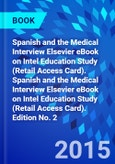Focusing on communication needs in real-world clinical situations, Dr. Pilar Ortega's updated edition of this practical text helps you address today's growing demand for Spanish-speaking physicians and healthcare workers. This pocket-sized resource provides basic Spanish skills, sample interview questions, relevant cultural information, and more, in addition to online videos of physician-patient interactions, interactive self-assessment tools, and clinical vignettes. You'll find exactly what you need to develop better physician-patient communication skills, increase your cultural competence, and make better clinical decisions in your practice.
- Understand the nuts and bolts of better communication through Spanish grammar, vocabulary, pronunciation, sample interview questions, and helpful interview techniques.
- Pocket size allows for quick reference in an easily accessible format. - Improve your skills with new and expanded content including more practice exercises for self-assessment, information on cultural issues, grammar tips and practice, complex clinical scenarios, and how to best use interpreters in your practice.
- Stay up to date with new chapters on pediatric health; common procedures and informed consent; the physician's impression and plan; diabetes medication; travel history and special exposures; adult immunization history; exercise and adult health safety screening; and specialized physical examination.
- Gauge and hone your doctor-patient communication skills with interactive self-assessment tools and practice exercises.
- Watch video of real-time physician-patient exchanges (with English and Spanish subtitles), complete interactive practice exercises, and learn from clinical vignettes-all online at Student Consult.
- eBook version included! Access the entire book online or offline across all devices with the Student Consult eBook.
- Understand the nuts and bolts of better communication through Spanish grammar, vocabulary, pronunciation, sample interview questions, and helpful interview techniques.
- Pocket size allows for quick reference in an easily accessible format. - Improve your skills with new and expanded content including more practice exercises for self-assessment, information on cultural issues, grammar tips and practice, complex clinical scenarios, and how to best use interpreters in your practice.
- Stay up to date with new chapters on pediatric health; common procedures and informed consent; the physician's impression and plan; diabetes medication; travel history and special exposures; adult immunization history; exercise and adult health safety screening; and specialized physical examination.
- Gauge and hone your doctor-patient communication skills with interactive self-assessment tools and practice exercises.
- Watch video of real-time physician-patient exchanges (with English and Spanish subtitles), complete interactive practice exercises, and learn from clinical vignettes-all online at Student Consult.
- eBook version included! Access the entire book online or offline across all devices with the Student Consult eBook.
Table of Contents
CHAPTER 1Basics of Conversational Spanish
1.1 Pronunciation
1.2 Syntax and Grammar
1.3 Verb Conjugation
1.4 Addressing the Patient: T? versus Usted
CHAPTER 2
Setting the Stage for the Clinical Encounter
2.1 General Greetings
2.2 Addressing the Patient
2.3 Provider's Introduction
2.4 Extended Introduction: Getting to Know the Patient
2.5 Setting the Agenda
CHAPTER 3
History of the Present Illness
3.1 Basic Anatomy
3.2 Chief Complaint
3.3 History of the Present Illness
CHAPTER 4
Past Medical History and Review of Systems
4.1 Past Medical History of Chronic Diseases
4.2 Past Medical History of Acute Diseases
4.3 Past Surgical History
4.4 Review of Systems
CHAPTER 5
Medications and Drug Effects
5.1 Medication History
5.2 Allergy History
5.3 Medication Instructions
5.4 Drug Side Effects
5.5 Diabetes Medication
CHAPTER 6
Family History
6.1 Naming Family Members
6.2 Talking about Family Life and Health
6.3 Family History
CHAPTER 7
Social and Sexual History
7.1 Assuring the Patient of Confidentiality
7.2 Social History
7.3 Travel History and Special Exposures
7.4 Substance Use History
7.5 Sexual History
7.6 Review of Reproductive Systems
CHAPTER 8
Mental Health and Cognition
8.1 General Mental Health
8.2 Spirituality and Health
8.3 Cognitive Assessment
8.4 Psychiatric History and Review of Systems
CHAPTER 9
Preventive Health and Nutrition
9.1 Access to Preventive Medical Care
9.2 Preventive Routine Screening Tests
9.3 Adult Immunization History
9.4 Exercise and Adult Health Safety Screening
9.5 Diet History
9.6 Body Mass Index, Special Diets, and Recommendations
CHAPTER 10
Pediatrics
10.1 Addressing the Pediatric Patient
10.2 Pregnancy, Delivery, and Neonatal History
10.3 Developmental History
10.4 Pediatric Safety
10.5 Immunization History
10.6 Infant Diet
10.7 Common Pediatric Illnesses
CHAPTER 11
Physical Examination
11.1 General Physical Examination
11.2 Specialized Physical Examination
11.3 Physical Findings
CHAPTER 12
Procedures and Informed Consent
12.1 Informed Consent
12.2 Discussing Common Procedures
12.3 Discussing Emergent Procedures
12.4 Advanced Directives
CHAPTER 13
Impression and Plan
13.1 Physician's Impression
13.2 Plan of Care: Additional Testing
13.3 Plan of Care: Treatment and Follow-up
13.4 Discussing Test Results
13.5 Delivering Bad News
13.6 System-Based Summary of Impression and Plan
13.7 Concluding the Visit
CHAPTER 14
Knowing your Limitations: When and How to Use a Medical Interpreter
14.1 When to Use a Medical Interpreter
14.2 Types of Medical Interpretation
14.3 Working Effectively with a Medical Interpreter
APPENDIX
Abbreviated Spanish Medical Interview Guide
Extended Spanish Medical Interview Guide
ANSWER KEY
BIBLIOGRAPHY
INDEX








